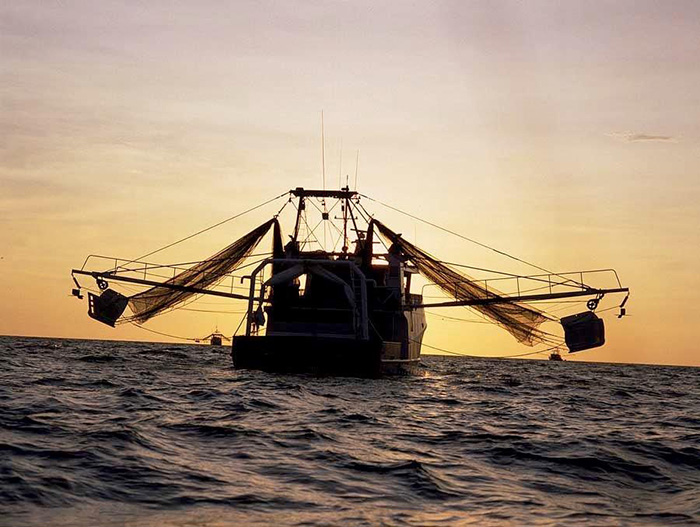Australia’s commercial prawn fishers are sharing their stories and engaging with communities to build trust and maintain their social license to operate.

The people, places and culture that shape Australia’s prawn fishers – and their desire to fish smarter, and more sustainably – are at the heart of a new community engagement campaign.
The Australian Wild Prawns’ ‘More than a Prawn’ video series features fishers from prawn fisheries around the country sharing their personal stories and experiences of working in the wild prawn sector. The videos are part of a two-year FRDC-funded research project examining different strategies to help the prawn fishery connect with the public.
The Australian Council of Prawn Fisheries (ACPF) led the research project that included, developing videos, creating a moderated social media campaign, and launching an interactive website. Other collateral included QR code-linked printed material for Woolworths, independent supermarkets and Gourmet Traveller magazine. It also produced an online virtual reality simulation of being on a prawn trawler.
ACPF Executive Officer Rachel King says the videos and the social media campaign have proved to be the key touchpoints for the community so the Council has continued to fund these elements beyond the end of the project. The research began in 2018, with filming taking 12 months to fit in with the fishing windows in the different prawn fisheries. The campaign was officially launched in March 2020.
Rachel says it was clear from the two-year public campaign that this initiative alone, was not enough to effectively build long-term trust. The conversation needs to be ongoing and is now being funded through the ACPF’s Industry Partnership Agreement with the FRDC.
Difficult conversations
The initial ACPF project was developed from findings from the Community Trust in Rural Industries initiative, a collaborative project involving all 11 Research and Development Corporations, including the FRDC. One of its key findings was that when industries are silent on difficult issues community members do not assume the best.
Rachel says transparency on progress to reduce bycatch and ensure stocks are sustainable, are two higher-priority issues the prawn sector needed to address before community concern escalated into the kind of outrage that could close a fishery. For example, public outrage temporarily, suspended Australia’s live sheep exports in the past and it also led to the rejection of supertrawlers fishing in Australian waters in 2014.
The ACPF project addressed issues of bycatch and stock sustainability in the ‘What We Care About’ video series, with related messages also woven into the ‘Our Stories’ fisher stories. The videos include supporting comments from researchers and fisheries managers, eNGO community stakeholders and chefs.
“Through the ’What We Care About’ stories, we acknowledge there have been problems, we explain the work done to address them, that we’re proud of the improvements we’ve made and that we’re looking to the future of the sector with more work to come,” Rachel explains.
Audience interaction
While the videos reached wide audiences, the social media campaign proved most effective in engaging with consumers. Rachel says expert moderation of social media was crucial, as having someone monitor and respond to hostile comments provided an opportunity to ‘de-escalate’ them. There have been more than 100 such conversations moderated since the launch in March 2020.
The social media campaign has also provided an opportunity to identify emerging issues. With much of the first year running during 2020-21 when COVID-19 and its impacts were top of mind, there were new concerns raised about ensuring Australian seafood was available for Australian consumers and truth-in-labelling on imported prawns.
The group who most actively engaged through the social media campaign were males (who were often recreational fishers). Rachel says there was comparatively little interaction generated from the information provided at the point of sale, such as in supermarkets, where the wild prawn purchasing demographic is primarily women, aged 55 years or older. Based on the various responses to the different engagement tools developed for the ACPF project, it was evident that the social media element of the campaign offered more time to explore issues of interest to these audiences.
Rachel says many of the prawn fishers who took part in filming for the project were motivated by public criticism about the wild prawn fishery. Prior to the campaign they had not had a mechanism for responding to critics. The carefully crafted stories the project has developed has given them the materials to do that. This project has also helped to instil pride in what they do and in how the sector has progressed.
The key findings from the ‘More than a Prawn’ campaign (March 2020 to date) include:
- 2.8M viewers via social media;
- 20.5 % actively engaged with content, watching videos;
- 100+ hostile conversations moderated and de-escalated.
- 5.2M reached via broadcast and print media
- 1.7M reached with interactive print media
This article relates to R&D Plan Outcome 5.





